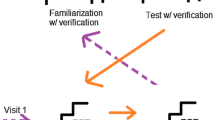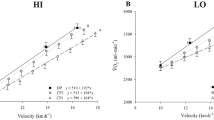Abstract
Purpose
The mediators of the perception of effort during exercise are still unclear. The aim of the present study was to examine physiological responses during runs using a rating of perceived exertion (RPE)-clamp model at the RPE corresponding to the gas exchange threshold (RPEGET) and 15% above GET (RPEGET+15%) to identify potential mediators and performance applications for RPE during treadmill running.
Methods
Twenty-one runners (\({\dot{V}\mathrm{O}}_{2}\)max = 51.7 ± 8.3 ml kg−1 min−1) performed a graded exercise test to determine maximal oxygen consumption and the RPE associated with GET and GET + 15% followed by randomized 60 min RPE-clamp runs at RPEGET and RPEGET+15%. Mean differences for \({\dot{V}\mathrm{O}}_{2}\), heart rate (HR), minute ventilation (\({\dot{V}}_{E}\)), respiratory frequency (\({\mathcal{F}}_{R})\), respiratory exchange ratio (RER), and velocity were compared across each run.
Results
After minute 14, \({\dot{V}\mathrm{O}}_{2}\), RER and velocity did not differ across conditions, but decreased across time (p < 0.05). There was a significant (p < 0.05) condition × time interaction for \({\dot{V}}_{E}\), where values were significantly higher during RPE-clamp runs at RPEGET+15% and decreased across time in both conditions. There were no differences across condition or time for HR, and only small difference between conditions for \({\mathcal{F}}_{R}\).
Conclusions
HR and \({\mathcal{F}}_{R}\) may play a role in mediating the perception of effort, while \({\dot{V}\mathrm{O}}_{2}\), RER, and \({\dot{V}}_{E}\) may not. Although HR and \({\mathcal{F}}_{R}\) may mediate the maintenance of a perceptual intensity, they may not be sensitive to differentiate perceptual intensities at GET and GET + 15%. Thus, prescribing exercise using an RPE-clamp model may only reflect a sustainable \({\dot{V}\mathrm{O}}_{2}\) within the moderate intensity domain.




Similar content being viewed by others
Abbreviations
- GET:
-
Gas exchange threshold
- vGET:
-
Velocity associated with GET
- vGET + 15%:
-
Velocity associated with 15% above GET
- \({\mathcal{F}}_{R}\) :
-
Respiratory frequency
- \({\mathcal{F}}_{R}\) max :
-
Maximal respiratory frequency
- HR:
-
Heart rate
- HRmax :
-
Maximal heart rate
- LT:
-
Lactate threshold
- (La−)b :
-
Blood lactate concentration
- RCP:
-
Respiratory compensation point
- RER:
-
Respiratory exchange ratio
- RERmax :
-
Maximal respiratory exchange ratio
- RPE:
-
Rating of perceived exertion
- RPEmax :
-
Maximal rating of perceived exertion
- RPEGET :
-
RPE corresponding with GET
- RPEGET+15% :
-
RPE corresponding with 15% above GET
- \({\dot{V}}_{E}\) :
-
Minute ventilation
- \({\dot{V}}_{Emax}\) :
-
Maximal minute ventilation
- vRPEGET :
-
Velocity corresponding to the RPE at GET
- vRPEGET + 15% :
-
Velocity corresponding to the RPE at 15% above GET
- \({\dot{V}\mathrm{O}}_{2}\) :
-
Oxygen consumption rate
- \({\dot{V}\mathrm{O}}_{2max}\) :
-
Maximal oxygen consumption rate
- \(v{\dot{V}\mathrm{O}}_{2max}\) :
-
Velocity at \({\dot{V}\mathrm{O}}_{2max}\)
References
Amann M, Proctor LT, Sebranek JJ, Eldridge MW, Pegelow DF, Dempsey JA (2008) Somatosensory feedback from the limbs exerts inhibitory influences on central neural drive during whole body endurance exercise. J Appl Physiol 105:1714–1724
Amann M, Blain GM, Proctor LT, Sebranek JJ, Pegelow DF, Dempsey JA (2010) Group III and IV afferents contribute to ventilatory and cardiovascular responses to rhythmic exercise in humans. J Appl Physiol 109:966–976
Beaver WL, Wasserman K, Whipp BJ (1986) A new method for detecting anaerobic threshold by gas exchange. J Appl Physiol 60(6):2020–2027
Bergstrom HC, Housh TJ, Zuniga JM, Camic CL, Traylor DA, Schmidt RJ, Johnson GO (2012) Estimated times to exhaustion, and power outputs at the gas exchange, physical working capacity at the rating of perceived exertion threshold, and respiratory compensation point. Appl Physiol Nutr Metab 37:1–8
Bergstrom HC, Housh TJ, Cochrane KC, Jenkins NDM, Zuniga JM, Buckner SL, Goldsmith JA, Schmidt RJ, Johnson GO, Cramer JT (2015) Factors underlying the perception of effort during constant heart rate running above and below the critical heart rate. Eur J Appl Physiol 115(10):2231–2241
Borg GA (1962) Physical performance and perceived exertion. Gleerup, Lund, pp 1–63
Borg GA (1970) Perceived exertion as an indicator of somatic stress. Scan J Rehabil Med 2:92–98
Borg GA (1982) Psychophysical bases of perceived exertion. Med Sci Sport Exerc 14(5):377–381
Borg GA (1998) Borg’s perceived exertion and pain scales. Human Kinetics, Champaign
Brooks GA, Fahey TD, Baldwin KM (2000) Exercise physiology: human bioenergetics and its applications. McGraw-Hill, New York
Carter H, Pringle JS, Jones AM, Doust JH (2002) Oxygen uptake kinetics during treadmill running across exercise intensity domains. Eur J Appl Physiol 86:347–354
Cochrane KC, Housh TJ, Bergstrom HC, Jenkins NDM, Johnson GO, Schmidt RJ, Cramer JT (2014) Perceptual and physiological fatigue threshold during cycle ergometry. JEP Online 17(5):95–107
Cochrane KC, Housh TJ, Bergstrom HC, Jenkins NDM, Johnson GO, Schmidt RJ, Cramer JT (2015a) Physiological responses during cycle ergometry at a constant perception of effort. J Sport Med 36:466–473
Cochrane KC, Housh TJ, Hill EC, Smith CM, Jenkins NDM, Cramer JT, Johnson GO, Schmidt RJ (2015b) Physiological responses underlying the perception of effort during moderate and heavy intensity cycle ergometry. Sports 3(4):369–382
Cooper CB, Storer TW (2005) Exercise testing and interpretation: a practical approach. Cambridge University Press, Cambridge
Dantas JL, Doria C, Rossi H, Rosa G, Pietrangelo T, Fano-Illic G, Nakamura FY (2015) Determination of blood lactate training zone boundaries with rating of perceived exertion in runners. J Strength Cond Res 29(2):315–320
Davis JA (1985) Anaerobic threshold: review of the concept and directions for future research. Med Sci Sport Exerc 17(1):6–18
Dempsey JA (1986) Is the lung built for exercise. Med Sci Sport Exerc 18(2):143–155
Dunbar CC, Robertson RJ, Baun R, Blandin MF, Metz K, Burdett R, Goss FL (1992) The validy of regulating exercise intensity by ratings of perceived exertion. Med Sci Sport Exerc 24(1):94–99
Enoka RM, Stuart DG (1992) Neurobiology of muscle fatigue. J Appl Physiol 72:1631–1648
Eston RG, Williams JG (1988) Reliability of ratings of perceived effort regulation of exercise intensity. Br J Sports Med 22(4):153–155
Gaesser GA, Poole DC (1996) The slow component of oxygen uptake kinetics in humans. Exerc Sport Sci Rev 241:35–71
Garber CE et al (2011) American College of Sports Medicine position stand Quantity and quality of exercise for developing and maintaining cardiorespiratory, musculoskeletal, and neuromotor fitness in apparently healthy adults: guidance for prescribing exercise. Med Sci Sport Exerc 43(7):1334–1359
Garcin M, Daniel M, Billat V (2008) Perceptual responses in free vs. constant pace exercise. Int J Sports Med 9(29), 453–459.
Housh TJ, Perry SR, Bull AJ, Johnson GO, Ebersole KT, Housh DJ, deVries HA (2000) Mechanomyographic and electromyographic responses during submaximal cycle ergometry. Eur J Appl Physiol 83:381–387
Kaufman MP (2010) Control of breathing during dynamic exercise by thin fiber muscle afferents. J Appl Physiol 109:947–948
Kaufman MP, Hayes SG (2002) The exercise pressor reflex. Clin Auto Res 12(6):429–439
Kindermann W, Simon G, Keul J (1979) The significance of the aerobic-anaerobic transition for the determination of work load intensities. Eur J Appl Physiol 42:25–34
Lander PJ, Butterly RJ, Edwards AM (2009) Self-paced exercise is less physically challenging than enforced constant pace exercise of the same intensity: influence of complex central metabolic control. Br J Sports Med 43:789–795
Marcora SM (2009) Perception of effort during exercise is independent of afferent feedback from skeletal muscles, heart, and lungs. J Appl Physiol 106:2060–2062
Marcora SM, Staiano W (2010) The limit to exercise tolerance in humans: mind over muscle? Eur J Appl Physiol 109:763–770
Martin BJ, Morgan EJ, Zwillich CW, Weil JV (1979) Influence of exercise hyperthermia on exercise breathing pattern. J Appl Physiol 47(6):1039–1042
Mielke M, Housh TJ, Malek MH, Beck TW, Schmidt RJ, Johnson GO (2008) The development of rating of perceived exertion-based tests of physical working capacity. J Strength Cond Res 22(1):293–302
Mielke M, Housh TJ, Hendrix CR, Camic CL, Zuniga JM, Schmidt RJ, Johnson GO (2009) Oxygen uptake, heart rate, and ratings of perceived exertion at the PWCVO2. J Strength Cond Res 23(4):1292–1299
Nicolò A, Marcora SM, Sacchetti M (2016) Respiratory frequency is strongly associated with perceived exertion during time trials of different duration. J Sport Sci 34(13):1199–1206
Nybo L, Nielsen B (2001) Hyperthermia and central fatigue during prolonged exercise in humans. J Appl Physiol 91(3):1055–1060
Pedhauzur EJ (1997) Multiple regression in behavioral research: explanation and predictions, 3rd edn. Harcourt College Publishers, Orlando
Poole DC, Ward SA, Gardner GW, Whipp BJ (1988) Metabolic and respiratory profile of the upper limit for prolonged exercise in man. Ergonomics 31(9):1265–1279
Ribeiro JP, Hughes V, Fielding RA, Holden W, Evans W, Knuttgen HG (1986) Metabolic and ventilatory responses to steady state exercise relative to lactate threshold. Eur J Appl Physiol 55:215–221
Robertson RJ, Goss FL, Dube J, Rutkowski J, Dupain M, Brennan C, Andreacci J (2004) Validation of the adult omni scale of perceived exertion for cycle ergometer exercise. Med Sci Sports Exer 36(1):108–203
Steed J, Gaesser GA, Weltman A (1994) Rating of perceived exertion and blood lactate concentration during submaximal running. Med Sci Sports Exer 26(6):797–803
Stoudemire NM, Wideman L, Pass KA, McGinnes CL, Gaesser GA, Weltman A (1996) The validity of regulating blood lactate concentration during running by ratings of perceived exertion. Med Sci Sports Exerc 28(4):490–495
Thompson WR, Gordon NF, Pescatello LS (2014) ACSM's guidelines for exercise testing and prescription, Hubsta Ltd.
Utter AC, Kang J, Robertson RJ (2001) American College of Sports Medicine current comment: perceived exertion. ACSM, Indianapolis
Whipp BJ (1987) Dynamics of pulmonary gas exchange. Circulation 76(1):19–29
Author information
Authors and Affiliations
Contributions
KCS and TJH conceived and designed the research. KCS, NDM, CMS, ECH conducted the experiments. KCS wrote the manuscript. TJH, NDM, CMS, ECH read and approved manuscript.
Corresponding author
Ethics declarations
Conflict of interest
The authors report no conflicts of interest related to this study.
Additional information
Communicated by I. Mark Olfert.
Publisher's Note
Springer Nature remains neutral with regard to jurisdictional claims in published maps and institutional affiliations.
Rights and permissions
About this article
Cite this article
Cochrane-Snyman, K.C., Housh, T.J., Smith, C.M. et al. Treadmill running using an RPE-clamp model: mediators of perception and implications for exercise prescription. Eur J Appl Physiol 119, 2083–2094 (2019). https://doi.org/10.1007/s00421-019-04197-4
Received:
Accepted:
Published:
Issue Date:
DOI: https://doi.org/10.1007/s00421-019-04197-4




